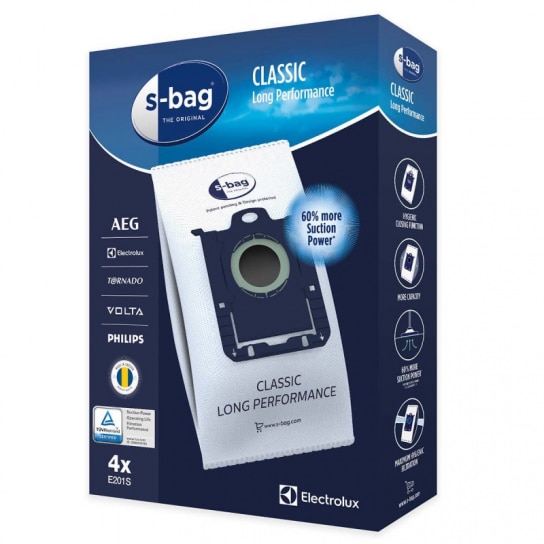As long as there have been vacuum cleaners, there have been dust bags. We take a walk down memory lane, stretching all the way back to the early 1900s.
1900s
The Lux 1 – the very first vacuum cleaner from Electrolux – was equipped with a dust bag made of cloth, and it was emptied manually.
The first really effective household vacuum cleaners came to be when fan technology replaced mechanical pumps. Fan technology (the same that’s used in today’s vacuum cleaners) gives far superior suction. The fan presses the air into the back of the vacuum cleaner and low pressure occurs in front of the fan. To even out the pressure, air blows in and brings along dust and dirt, which is then separated by the dust bag.
1920s
Even in the 1920s, people realized that the exhaust air from the vacuum cleaner contained different types of bacteria that were not captured by the bag.
That’s why, in 1926, Electrolux introduced in its model XI a filter for bacteria that cleaned exhaust air. The filter was treated with a strong disinfectant and with an aromatic substance to make vacuuming more pleasant. The new filter gained interest all over the world. It was even tested at the city of Paris’s hygienic laboratory and received very good results.
1950s
In the 1950s, paper dust bags came into the arena and began to be tested. In this era, Electrolux presented a thin insert paper bag that was used inside the cloth bag. This made emptying the bag easier. The paper dust bag was thrown away when it was full and there was no longer a need to shake the cloth bag.
The next major event in the history of the dust bag came in 1952 when the American Electrolux Corporation introduced its new vacuum model LX with a self-sealing bag made completely out of paper. This marked a small revolution in homes. Users now were able to vacuum clean without ever coming into contact with dirt and dust. No flying dust when the user opened the lid, no bags needing shaking — simply a nice, clean bag to be put in the trash.
1960s
It wasn’t until 1964 that the paper dust bags came to Europe. It was then that the Electrolux LUXOMATIC was introduced. This vacuum cleaner gained a great deal of attention with its three automatic features: the self-sealing paper dust bag, the automatic cord winder, and the dust bag indicator, which shows when the dust bag needs changing.
After LUXOMATIC, the use of the paper dust bag spread throughout Europe. However, developments were rather slow. As late as the 1970s, it was fairly common for consumers to prefer cloth bags to paper bags.
1980s
In the 1980s and 1990s, the selection of vacuum cleaners — and likewise dust bags — increased abundantly. While there are no exact figures, estimates show that there are about 300 different variations of the dust bag in Europe alone!
The bags were refined and equipped with hygienic seals. Electrolux Excellio is an example of this. To remove the bag, the user lifts a special tab handle, which automatically seals the bag while it’s carried to the trash. Bags have also been equipped with better filters with the development of different types of paper and the use of layers.
The increasing number of bag types, however, causes several problems. One is that consumers have more and more difficulty finding the right bags. The other is that the manufacturing costs increases because fewer bags can be delivered between each process change in the factories. A solution would have to wait until the 1990s.

A unique collaboration between Electrolux and Philips led to the invention of the s-bag
1998
To remedy this problem, Electrolux initiated a project to develop a flexible dust bag that can be used for all cylinder vacuum cleaners. Teaming up with Philips, this resulted in the “s-bag.”
This unique collaboration between Philips and Electrolux also created a platform for an industry standard for the next century, making things easier for both manufacturers and consumers around the world.
2018
It was time to re-innovate the s-bag last year. The aftermarket had grown and competition was getting fierce, and the s-bag needed to stay competitive. The team had to find a solution that was backward-compatible with 60 vacuum cleaner families (Philips and Electrolux) as well as one that would work well with upcoming vacuum ranges, and of course still meet high demands on quality and performance.
The new, improved s-bag has been redesigned to ensure it closes every time and doesn’t break or leak. It’s also more durable, thanks to the use of a stronger material and a new sealing technology that uses double-molding. Plus the new design has a collar that can be bent, saving space in the dust bag compartment in new cleaners. Designed with the environment in mind, the s-bag also delivers the highest performance possible using as little material as possible.
The future?
We continue to focus on product innovation to deliver outstanding consumer experiences. What does this mean for the future of the dust bag? Watch this space.

